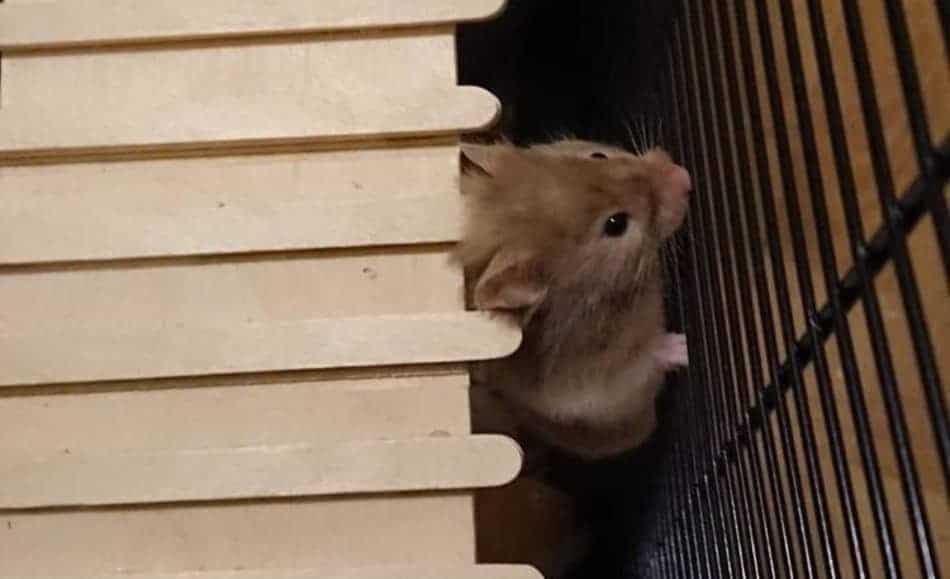Hamsters do a lot of funny, quirky things every day that entertain us and make us laugh. Some of these things, such as cage climbing, or “monkey barring,” might not be as entertaining as we may think and could indicate something is wrong.
So, why is my hamster monkey barring? There are a couple things that could be going on, but the most likely reason is because your hamster is displeased with something about its environment.
In this article we will discuss how your hamster’s enclosure size can affect its behavior, a hamster’s energy levels and need for multiple energy outlets, how boredom can translate to stress, and finally, how some hams just have quirky personal preferences.

All About the Square Footage
Contrary to popular belief, domestic hamsters actually need quite a bit more space than what is typically marketed for them in pet stores. In the wild, hamsters will roam for miles to forage for food that they will take back to their burrows, while domestic hamsters have been recorded running upwards of five miles in a night on their wheels.
This means that it is incredibly important to choose an enclosure that is big enough to support your hamster’s active lifestyle.
If your furry friend has been spending a lot of time hanging from the rafters, so to speak, examine the enclosure in which it lives to be sure it has enough space. One of the most common causes of this behavior is improperly sized enclosures.
The minimum recommended cage size (in the United States) is 24 inches by 12 inches, with at least 12 inches of height, but bigger is certainly better when it comes to the well-being of our pets.
If your enclosure is 24 x 12 x 12 inches or smaller, chances are your pal is going a little stir-crazy in a too-small space. This could lead to stress, anxiety-related conditions and behaviors, or injury.
Furthermore, if your pet is indeed suffering from cabin fever, their monkey barring antics may be escape attempts. As natural explorers, feeling trapped may compel hamsters to search for ways out of their enclosure, including from above.
Additionally, hamsters can be quite impressive escape artists, so for the safety of your pet, ensure the enclosure is secure. If you have multiple hamsters housed together, specifically solitary Syrian hamsters, they might be displaying this behavior to get away from cage mates with whom they do not get along.
In any case, either with a too-small living space or bad roommates, look for other enclosure-related stress signals like bar-biting or uncharacteristic aggression.
If you suspect your pocket-sized pal may be monkey barring out of enclosure-related stress, it is time to consider an upgrade. If you have an enclosure that consists of multiple “rooms” connected by tubes and runs, make sure at least one of those rooms either matches or is larger than the dimensions above.
If you do not have a main area for your pet that matches those dimensions, consider adding another enclosure or upgrading the entire system for your furry friend’s safety and wellness. If your hamster’s enclosure seems to be large enough and you do not suspect escape attempts, your pocket-sized pal may be bursting with energy that it has no other place to let out.
A Lot of Power, No Outlets
As discussed above, hamsters in the wild roam for miles in search of food that they bring back to their burrows to store. Those burrows consist of multiple tunnels and “rooms” that they dig themselves and are constantly upgrading. Furthermore, hamsters are prey animals, meaning they are on the menu for a lot of other creatures.
This has made their senses (excluding their poor eyesight) very sharp so they can be on constant alert for danger. They are also quite fast and agile and consume a high-powered diet rich in carbohydrates. Combine all these factors and the result is a recipe for an extremely high-energy animal who needs to move…a lot.
You have already determined that your hamster’s enclosure is large enough—now take another look. What is inside your pet’s habitat? Does it have a running wheel? Plenty of toys? How about chewing blocks? Are there climbing toys like ladders or hammocks, and/or multiple levels to your hamster’s enclosure?
If you answered ‘no’ to more than two or three of those questions, chances are your furry friend is bored and hanging around on the bars of its enclosure is the only source of entertainment it can find.
Hamsters can become bored quite easily for all the reasons listed above, plus the fact that they are mischievous, quirky, little devils in general. Along with providing an adequately sized enclosure, it is our responsibility to make sure our pals have plenty of enrichment therein.
In addition to the items listed above, make sure your hamster has lots of space and substrate, or bedding, in which to dig, and offer supervised time outside of the enclosure in a hamster ball.
Also consider “scatter feeding” from time to time, which is basically exactly what it sounds like: instead of putting all their food in a bowl, scatter it around so they must root through their substrate to find it. This is particularly enriching for our friends as it mimics the way they forage for food in the wild.
Ensuring your furry friend is boredom-free is quite important, because for hamsters, boredom often quickly leads to stress and/or anxiety.
Deep Breaths
Being such tiny prey animals, hamsters are understandably quick to become stressed or anxious in their environments, including in our homes.
There are several factors, in addition to boredom, to consider when determining whether the environment your pal inhabits is conducive to a calm, happy ham, but fear not—it does not take much adjusting to correct for any stressors that emerge. Before considering stress as a driver behind this behavior, be on the lookout for common signs of stress like these:
- Hyperactivity
- Compulsive or unusual behavior (such as bar-biting or excessive grooming)
- Uncharacteristic aggression
- Snorting or grunting
- Excessive salivation
- Persistent escape attempts
- Muscle rigidity or tremors
If your furry friend has an adequately sized enclosure and displays some or all these other behaviors, it could be monkey barring out of stress. Take time to determine what stressors, if any, could be affecting it.
First, make sure the room your hamster’s enclosure is in is kept dry and between 65- and 75-degrees Fahrenheit, since our furry friends hail from warm, dry climates. If the room is too warm or cool, your hamster may become distressed. Further, make sure the room in question has a predictable lighting schedule with gentle light for our nocturnal friends.
Too much bright light interferes with our pets’ delicate senses and internal clocks which can cause a great deal of stress. Try to keep the enclosure in a quiet place away from busy, loud noises and ultrasound—their sensitive ears pick up on it when we cannot.
Sources of ultrasound include television, computer monitors, and household appliances. Finally, always make sure to keep your hamster’s enclosure, hides, water, and food bowls clean. In addition to the above environmental stressors, other inhabitants of your home could be a source of stress for your furry friend.
If other pets, specifically predatory animals like cats or dogs, share a room or spend a significant portion of the day in the same space as your hamster, they could be causing your quick-to-worry prey animal friend a great deal of distress.
Like the bad roommate scenario above, your hamster may be monkey barring not only from stress, but as an escape attempt to get away from what it perceives as a potential predator.
Even if your other pets are quite gentle around your hamster, its nature is to be afraid of them. To the best of your ability, keep your hamster in a room where the other animals do not have to spend a lot of time. This will help the wellbeing of everyone in the home.
If you have a happy, healthy hamster with its own little dream home and a safe, welcoming environment, perhaps your pal is just quirky.
Some Hamsters Just Wanna Have Fun
Hamsters are popular pets because, in addition to being (mostly) straightforward to care for, they have quite large personalities packed into tiny little fuzzy bodies. Individual hamsters have individual preferences, and are even stricken with “moods,” like us and many other animals. As discussed earlier, hamsters are high-energy critters, and they are also naturally curious.
These traits coupled with their unique personality quirks means some hamsters are simply more compelled to climb than others. Some hamsters enjoy climbing just so they can jump or flip from whatever height they find themselves.
Others, ever the explorers, are simply curious as to what might be up there. In any case, if you have not discovered any negative factors such as those discussed above and suspect you may just have a thrill-seeker on your hands, there are still some steps to consider taking for its safety.
As with any of the above situations, your hamster risks falling and injuring itself if it climbs too recklessly. If you have a persistent climber, add extra bedding beneath the areas it climbs to cushion a fall.
Further, you can add additional levels to your pal’s enclosure to shorten the distance of a potential fall and prevent injury. As a bonus, adding levels may also reduce your hamster’s temptation to monkey bar since it has other things to climb. Provided you are vigilant about injury prevention, this behavior, by itself, is no cause for concern.
Conclusion
If your furry friend has been spending a lot of time monkey barring, it likely needs more space. Make sure your hamster’s enclosure is adequately sized or perform some upgrades. Additionally, your hamster may need more enrichment within its enclosure. Be sure to provide plenty of entertainment for your easily bored companion.
Your hamster may also be monkey barring out of stress, so in addition to offering plenty of enrichment, make sure the environment surrounding your pal’s enclosure is safe and welcoming. Finally, monkey barring behavior could simply be a result of your hamster’s personal preferences.
In any case, ensure you are providing some safety nets (not literally) for your furry friend in case it falls.
Provided you are vigilant about your hamster’s wellbeing and safety, monkey barring behavior can be corrected, or at the very least determined to be unharmful, and you and your companion can go about enjoying each other’s antics with peace of mind.




